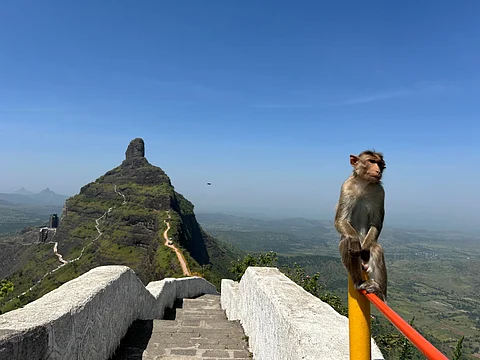
- Destinations
- Experiences
- Stay
- What's new
- Celebrating People
- Responsible Tourism
- CampaignsCampaigns
- SubscribeSubscribe
- Buy Now

Nestled in the Satana taluka of Nashik district in Maharashtra, Mangi-Tungi is a significant site for Jain pilgrimage and stands as one of the key heritage sites of the state. Renowned for its twin hills and the world's tallest Jain idol carved out of a single rock, the site draws tourists that are a mix of religious travellers, history aficionados and nature photographers. Existing outside the ambit of mainstream tourist circuits, Mangi-Tungi is a monumental representation of ancient Jain faith expressed through its monolithic architecture and enduring spiritual legacy. Here, we take a dive into the nooks and crannies of the site and find out why it's a must-visit spot in Maharashtra.
With its serene landscape and spiritual aura, the site offers a journey through centuries of ascetic traditions and architectural marvels.
Mangi-Tungi stands about 125 kilometres from Nashik city and is composed chiefly of two adjacent hills—Mangi to the west and Tungi to the east—both rising to over 1,300 metres above sea level. The two peaks, forming a picturesque sight to behold, are separated by a narrow saddle and are accessible via a stone staircase of over 4,000 steps. The hills lie near the village of Tahrabad and can be reached via state highways, with Satana being the closest major town, about 30 kilometres away.
For centuries, Mangi-Tungi has been a centre for the Jain faith. According to the Jain scriptures, many Tirthankaras and other revered saints attained nirvana at this site. In addition, Mangi-Tungi is historically associated with legends of Rama, Sita and Hanuman, alongside other figures from ancient Indian epics, though Jain interpretations dominate current perception of the site. Inscriptions found here date back to the 8th and 9th centuries CE, with some idols believed to be over a thousand years old.
Mangi-Tungi is home to over 400 Jain caves carved into both hills. These caves contain small shrines (known as gumbajis) that accommodate sculptures of Jain Tirthankaras, yakshas (a class of nature spirits in Hindu, Buddhist, and Jain mythology), and yakshis. The caves are identified by their inscriptions and are often named after saints believed to have meditated there. Notable ones include the cave of Lord Mahavira and Lord Rishabhanatha. The site is divided into sectors, and each cave typically contains one or more idols in various postures—padmasana (lotus) or kayotsarga (standing meditation).
The most iconic exhibit of Mangi-Tungi is the 108-foot monolithic statue of Lord Rishabhanatha (Adinath), the first Jain Tirthankara. Completed in 2016 after nearly a decade of carving, it holds the Guinness World Record for the tallest Jain idol in the world carved from a single rock. The statue, known as the Statue of Ahimsa, stands on Tungi hill and depicts the Tirthankara in the kayotsarga posture. Surrounding the statue are various temple complexes and a dharmashala for pilgrims.
Mangi-Tungi is one of the most important pilgrimage sites in the Digambara Jain tradition. The Sanskrit word Digambara means "sky-clad", referring to their monastic practice of renouncing all possessions, including clothing. Devotees from across India visit the site for spiritual merit and to fulfil religious vows. This spiritual journey witnesses a culmination in the form of Mangi-Tungi Mahotsav, an annual religious fair, attracting thousands. It features mass prayers, lectures, and rituals. The grand Pratishtha Mahotsav of the Rishabhanatha statue in 2016 was one of the largest religious events in modern Jain history, drawing participants from more than 20 countries.
The site is managed by the Mangi-Tungi Tirtha Kshetra Committee and offers several dharmashalas (pilgrim rest houses), bhojanalayas (community kitchens), and water facilities. Electricity and mobile network coverage are available at the base. Basic amenities for overnight stays and meals are primarily catered to pilgrims. Private transport is recommended, as public transport access is limited beyond Satana.
The Archaeological Survey of India (ASI) and local Jain committees, such as the Shri Mangi-Tungi Digambar Jain Siddha Kshetra Trust, jointly oversee the preservation and care of heritage structures. Given the religious sensitivity and historical importance of the site, conservation efforts tend to focus on minimal intervention, stone treatment and preservation of inscriptions.
Although not always officially recorded in state archaeological records, preservation efforts include preserving the structural soundness of carvings that date back hundreds of years, protecting inscriptions in antiquated scripts, and controlling pilgrim traffic by controlling access and maintaining the 3,500-step path. In addition to permitting the regular restoration of damaged idols and temple structures, the site's management guarantees cleanliness, environmental balance, and cultural holiness. By preserving the site's spirituality and legacy, these initiatives want to keep it a living reminder of Jain devotion and historical significance.
Visitors are expected to adhere to the ethics of the space and follow non-violent principles and avoid leather products or meat-based food within the premises.
Travellers to Mangi-Tungi often combine their visit with other heritage and religious sites in Nashik, including the Trimbakeshwar Shiva Temple and Saptashrungi. The region also offers opportunities for trekking and exploration of lesser-known cave temples in the Western Ghats.
Mangi-Tungi is open year-round, but the winter months from November to February are most suitable due to the moderate climate. Summer temperatures can exceed 40°C, making the long stair climb strenuous. The monsoon season sees lush greenery but slippery steps, so caution is advised.
